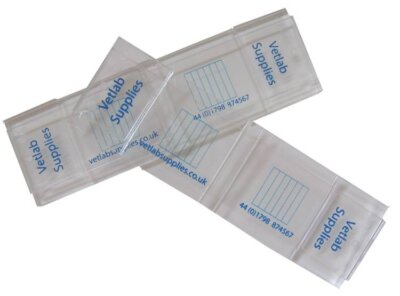
The restrictions imposed during the worst of the Covid-19 pandemic forced keepers of pet, domestic and rescued animals to carry out their own parasite load monitoring using the McMaster Slide Faecal Egg Count (FEC) test.
With veterinary practices and diagnostics mostly back to normal, many keepers continue to easily and cost effectively monitor their own animals. Here’s how to get started with only the most essential of veterinary laboratory equipment and an easy to follow McMaster Slide Counting Method.
Get Started In DIY Faecal Egg Monitoring
The McMaster Slide method of estimating the parasite load of an animal is made up of just four easy to understand and perform steps.
First, separate the worm eggs from a sample of the animal’s faeces. Second, find the eggs (oocytes) using a microscope and, third, count them. Finally, knowing both the weight of faeces sampled and the number of worm eggs counted, calculate the animal’s likely level of worm infection.
Egg Counting: What You Need – Flotation Solutions
Not as obvious as the microscope and McMaster counting slide, the Flotation Solutions are the key to the success of egg counting and identification. Flotation solutions are made to a standard or customer specified, specific gravity (SG) more usually known as density.
The fluid density is chosen such that faecal matter and other debris is more dense than the solution and so sinks. But the parasite eggs are less dense, and so float to the top making finding, counting and identifying them straightforward with the right equipment.
Egg Counting: What You Need – The Microscope
Essential to starting out on faecal egg monitoring is a microscope capable of ranging from 40-times (x40) to 100-times (x100) magnification. The Vetlab Premiere Range of microscopes are economical, easy to use and popular with diagnostic and teaching laboratories.
The microscope will be used to find and count the number of parasite eggs present in a small sample of animal faeces. With a bit of practice it’ll become straightforward not only to estimate the number of eggs, but even identify the likely species of worm causing infection.
Egg Counting: What You Need – The McMaster Counting Slide
The McMaster Counting Slide is the simple yet brilliantly adapted microscope slide used and relied upon by animal health practitioners since 1939. Made in glass or tough acrylic plastic, the slide is basically the carrier for a square cavity of known volume – usually 0.15ml.
After a sample of faeces, treated with a specific ‘flotation solution’ is placed in the McMaster Slide cavity and covered with a second, thinner slide. Parallel lines etched into this ‘cover slide’ create five equal divisions. Viewed with the microscope, the floating parasite eggs – just under the cover slip – can be counted and identified within each division.
Egg Counting: What You Need – The Simple Final Calculation
With a little practice, counting the number of parasite eggs seen within the grid lines of the McMaster Slide becomes a quick and easy routine.
As long as the Vetlab McMaster Slide Counting Method has been followed precisely, all that remains is to multiply the counted number of parasite eggs by 25 to get the number of eggs per gram (e.p.g.) of animal faeces.
For more information on the Vetlab McMaster Slide Count Method, veterinary laboratory equipment, ready-made or customised flotation solutions, search or click Vetlab F.E.C Kits & Equipment
For further information visit our website www.vetlabsupplies.co.uk or call 01798 874567

